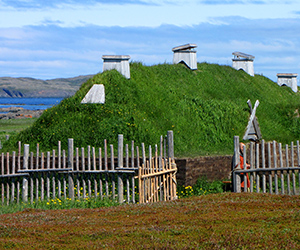CANADA HISTORY - Politics-Provinces
POLITICS - NOVA SCOTIA
Nova Scotia’s history begins in the ancient past, long before European settlers, with the Mi’kmaq, the Indigenous people who lived throughout the region for thousands of years. The Mi’kmaq, who called the land Mi’kma’ki, had a deep connection to the rivers, forests, and coasts of the region. They lived by hunting, fishing, and gathering, their seasonal movements governed by the rhythms of nature. Their society was highly organized, with a system of alliances and trade that spanned the Atlantic region. The arrival of European fishermen and traders in the 16th century marked the beginning of a new chapter in this land’s history, as the Mi’kmaq established trade relations with the newcomers, exchanging furs for European goods.
The first permanent European settlers in Nova Scotia were the French, who established the colony of Acadia in the early 1600s. Samuel de Champlain and Pierre Dugua, Sieur de Mons, founded the settlement of Port-Royal in 1605, laying the foundations for what would become one of the oldest continuous European settlements in North America. Acadia, nestled between the powerful French colony of New France and the English colonies to the south, was a small, self-sufficient colony of farmers, fishermen, and traders. The Acadians developed a unique culture, distinct from both the French of New France and the British, and became known for their agricultural ingenuity, particularly their system of dykeland farming, which transformed tidal marshlands into productive farmland.
Acadia’s strategic position, at the gateway to the St. Lawrence River and the heart of French and English territorial ambitions in North America, made it a battleground between the two great powers. Throughout the 17th and early 18th centuries, Nova Scotia was repeatedly contested by the French and British, changing hands several times during the colonial wars that marked the era. The Treaty of Utrecht in 1713 finally ceded mainland Nova Scotia to the British, though France retained control of Île Royale (Cape Breton Island) and Île Saint-Jean (Prince Edward Island). The French built the fortress of Louisbourg on Cape Breton to protect their fishing and trade interests in the region, and it quickly became a major center of French power in the Atlantic.
The Acadians, caught between these rival empires, tried to maintain their neutrality, but their position became increasingly precarious as tensions escalated. The British, concerned that the Acadians might side with France in any future conflict, demanded that they swear an unconditional oath of allegiance to the British Crown. When the Acadians refused, fearing it would force them to fight against their French brethren, the British undertook one of the darkest chapters in Nova Scotia’s history—the Expulsion of the Acadians. Beginning in 1755, British authorities rounded up thousands of Acadians, burning their homes and farms, and deporting them to the American colonies, Britain, and France. Many of those displaced eventually found their way to Louisiana, where they became the ancestors of the Cajun people.
With the Acadians removed, the British sought to solidify their control over Nova Scotia by encouraging settlement by Loyalists and immigrants from New England and the British Isles. Halifax, founded in 1749 as a military stronghold, became the new colonial capital, and it rapidly grew into a major port and naval base. The British victory in the Seven Years’ War in 1763, which resulted in the fall of Louisbourg and the expulsion of France from mainland North America, secured British control over Nova Scotia and marked the end of the French colonial presence in the region.
During the American Revolution, Nova Scotia remained loyal to Britain, although there was some sympathy for the revolutionary cause among the colony’s population. The province’s loyalty was cemented by the influx of thousands of Loyalist refugees who fled the United States after the war. These Loyalists, many of whom were from the Thirteen Colonies, transformed Nova Scotia’s population and economy. They established new settlements, particularly in what would become New Brunswick, which was separated from Nova Scotia and made a separate colony in 1784. The Loyalists brought with them their agricultural and commercial expertise, and they helped lay the foundations for the province’s growth in the 19th century.
The 19th century was a period of significant development for Nova Scotia, as it transitioned from a frontier colony to a more settled and prosperous province. The economy was driven by shipbuilding, fishing, and trade, particularly with Britain and the West Indies. Nova Scotia’s forests provided timber for the construction of the famed wooden sailing ships that were built in shipyards along the coast. The province became a leader in the production of these ships, known as "Bluenose" schooners, which were prized for their speed and craftsmanship. The most famous of these was the racing schooner Bluenose, launched in 1921, which became a symbol of Nova Scotia’s maritime heritage.
Politically, Nova Scotia was at the forefront of the movement toward responsible government in British North America. In 1848, under the leadership of reformers like Joseph Howe, Nova Scotia became the first colony in the British Empire to achieve responsible government, meaning that the executive branch of the government was accountable to the elected assembly. Howe, a journalist and politician, became one of Nova Scotia’s most influential leaders, advocating for democratic reforms and the rights of free speech and self-government.
Despite its early political leadership, Nova Scotia was initially reluctant to join Confederation in the 1860s. Many Nova Scotians feared that their interests would be overshadowed by the larger provinces of Ontario and Quebec, and there was significant opposition to the idea of joining the new Canadian federation. However, economic factors, including the promise of railway connections and trade opportunities with the rest of Canada, eventually swayed public opinion. In 1867, Nova Scotia became one of the four original provinces of Canada, though anti-Confederation sentiment remained strong for many years.
The late 19th and early 20th centuries were a time of industrial growth and modernization in Nova Scotia. Coal mining, particularly in Cape Breton, became a major industry, fueling the province’s railways, factories, and shipping industries. Steel production also took root in the industrial towns of Sydney and Trenton. However, the province’s economy remained vulnerable to fluctuations in global markets, and the collapse of the coal and steel industries in the mid-20th century had a devastating impact on many communities, particularly in Cape Breton.
World War I and World War II brought both hardship and economic opportunity to Nova Scotia. Halifax, as a major port, played a critical role in the Allied war effort during both wars. The city became a hub for the assembly of convoys that transported troops and supplies across the Atlantic, and it was also the site of the largest man-made explosion before the advent of nuclear weapons—the Halifax Explosion of 1917. A munitions ship in Halifax Harbour collided with another vessel, triggering a massive explosion that leveled much of the city and killed nearly 2,000 people.
The post-war period saw significant social and political changes in Nova Scotia. The province’s economy diversified, with the rise of manufacturing, tourism, and service industries. The construction of the Canso Causeway in 1955, connecting Cape Breton Island to the mainland, facilitated transportation and economic development. However, the decline of traditional industries such as fishing and shipbuilding, coupled with the closure of coal mines and steel mills, led to economic challenges, particularly in rural areas.
Politically, Nova Scotia continued to evolve. The province’s political landscape has long been dominated by the Liberal and Conservative parties, with occasional victories by the New Democratic Party (NDP). In 2009, Darrell Dexter led the NDP to its first-ever provincial victory, marking a significant shift in Nova Scotia’s political history. The province has also been home to notable political leaders, including Robert Stanfield, a long-serving premier of Nova Scotia and leader of the federal Progressive Conservative Party, and John Savage, who introduced major reforms in health care and education during his tenure as premier in the 1990s.
Today, Nova Scotia is a province that balances its rich history with modern development. Its economy, once centered on traditional industries, has diversified into sectors such as information technology, aerospace, and biotechnology. The province’s stunning natural beauty and vibrant cultural heritage, including its Acadian, Mi’kmaq, and Gaelic traditions, continue to draw tourists from around the world. Halifax, with its universities, cultural institutions, and thriving port, remains the economic and political heart of the province, while rural communities retain their deep connection to the land and sea.
Nova Scotia’s history is one of resilience and adaptation. From the early Mi’kmaq and Acadian settlers to the Loyalists and shipbuilders, the people of Nova Scotia have navigated centuries of change, conflict, and opportunity. Its leaders, from Joseph Howe to Robert Stanfield, have played pivotal roles in shaping both the province and the nation of Canada. As Nova Scotia continues to evolve in the 21st century, its history serves as a reminder of the enduring strength of its people.












